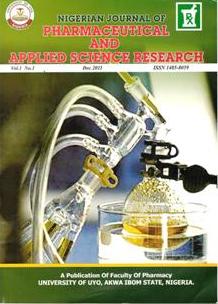Analgesic and Anti-Inflammatory (Acute and Sub-Acute) Properties of the Methanol Extract of the Whole Cassytha Foliformis Plant
Contenu principal de l'article
Résumé
Background: Cassytha filiformis (family Lauraceae) is traditionally used to treat pain and inflammation, but scientific validation is limited. This study evaluated the analgesic and anti-inflammatory activities of its methanol whole plant extract.
Methods: The powdered plant was extracted by cold maceration in methanol. Acute oral toxicity was assessed using Lorke’s method. The extract was tested at oral doses of 100, 200, and 400 mg/kg. Analgesic activity was evaluated using acetic acid-induced writhing, hot plate, and formalin-induced pain tests in mice. Aspirin (100 mg/kg, oral) and pentazocine (10 mg/kg, i.p.) served as positive controls; distilled water (2 ml/kg, oral) was the negative control. Anti-inflammatory activity was assessed using carrageenan-, dextran-, and formalin-induced paw edema in rats, with indomethacin (10 mg/kg, oral) as the reference drug.
Results: The extract showed no signs of toxicity. It significantly (p<0.05) reduced writhing in the acetic acid model and increased pain threshold in the hot plate and formalin models compared to the control. It also significantly (p<0.05) inhibited paw edema in all inflammatory models, indicating both acute and sub-acute anti-inflammatory effects.
Conclusion: The methanol extract of Cassytha filiformis whole plant possesses significant analgesic and anti-inflammatory activities, supporting its traditional use in pain and inflammation management.
Téléchargements
Renseignements sur l'article

Cette œuvre est sous licence Creative Commons Attribution - Pas d'Utilisation Commerciale - Pas de Modification 4.0 International.
Références
Ekor M. The growing use of herbal medicines: issues relating to adverse reactions and challenges in monitoring safety. Front Pharmacol. 2014 Jan 10;4:66193.
Ernst E. Herbal medicines: balancing benefits and risks. In: Dietary Supplements and Health: Novartis Foundation Symposium 282. Chichester, UK: John Wiley & Sons, Ltd; 2007 Jul 27. p. 154-72.
Paulos B, Fenta TG, Bisrat D, Asres K. Health seeking behavior and use of medicinal plants among the Hamer ethnic group, South Omo zone, southwestern Ethiopia. J Ethnobiol Ethnomed. 2016 Dec;12:1-3.
Adonu CC, Ugwu OP, Esimone CO, Ossai EC, Bawa A, Nwaka AC, Okorie CU. Phytochemical analyses of the menthanol, hot water and N-hexane extracts of the aerial parts of Cassytha filiformis (Linn) and leaves of Cleistopholis patens (Benth).
Cassytha filiformis (PROSEA). PlantUse English. 2023 Mar 23 [cited 2023 Oct 2, 15:25]. Available from: https://uses.plantnet-project.org/e/index.php?title=Cassytha_filiformis_(PROSEA)&oldid=334529
Ambi AA, Nuru GF, Mora AT, Ahmad A. Pharmacognostic studies and elemental analysis of Cassytha filiformis Linn. J Pharmacogn Phytother. 2017 Aug 31;9(8):131-7.
Nagarani N, Balu M, Pragna CH. Analgesic, anti-pyretic and anti-inflammatory activity of Cassytha foliformis. Int J Pharm Biol Sci. 2020 Jan 15;10(2):17-26.
Institute of Laboratory Animal Resources (US). Committee on Care, Use of Laboratory Animals. Guide for the care and use of laboratory animals. Bethesda (MD): US Department of Health and Human Services, Public Health Service, National Institutes of Health; 1986.
Lorke D. A new approach to practical acute toxicity testing. Arch Toxicol. 1983 Dec;54:275-87.
Biswas M, Biswas K, Karan TK, Bhattacharya S, Ghosh AK, Haldar PK. Evaluation of analgesic and anti-inflammatory activities of Terminalia arjuna leaf. J Phytol. 2011 Jan 19;3(1).
Paramaguru R, Jagadeeshwar K, Kumar CB, Raj NA. Evaluation of anti-inflammatory activity on the leaves of Filicium decipiens in experimental animal models. J Chem Pharm Res. 2011;3(3):243-7.
Winter CA, Risley EA, Nuss GW. Carrageenin-induced edema in hind paw of the rat as an assay for antiinflammatory drugs. Proc Soc Exp Biol Med. 1962 Dec;111(3):544-7.
Sammaiah G, Thirupathi K, Srivastava RS. Anti-inflammatory and antinociceptive effects of the alcoholic extract of Indian Polygala arvensis in experimental animals. East Cent Afr J Pharm Sci. 2007;10(2):39-44.
Koster R. Acetic acid for analgesics screening. Fed Proc. 1959;18:412-7.
Shetty SN, Anika SM. Laboratory manual of pharmacology and toxicology. Enugu, Nigeria: Fourth Dimension Publishers; 1982.
Franzotti EM, Santos CV, Rodrigues HM, Mourao RH, Andrade MR, Antoniolli AR. Anti-inflammatory, analgesic activity and acute toxicity of Sida cordifolia L. (Malva-branca). J Ethnopharmacol. 2000 Sep 1;72(1-2):273-7.
Shibata M, Ohkubo T, Takahashi H, Kudo T, Inoki R. Studies of inflammatory pain response: related pain producing substance and endogenous opioid system. Nihon Yakurigaku Zasshi. Folia Pharmacol Jpn. 1986 Apr 1;87(4):405-15.
Erhirhie EO, Ihekwereme CP, Ilodigwe EE. Advances in acute toxicity testing: strengths, weaknesses and regulatory acceptance. Interdiscip Toxicol. 2018 May 1;11(1):5-12.
Aziz TA, Marouf BH, Mohamood NM, Hussain SA. Anti-inflammatory activity of Benfotiamine in adjuvant-induced arthritis and cotton pellet-induced granuloma models of inflammation in rats. Glob J Pharmacol. 2011;5:86-91.
Munjal A, Allam AE. Indomethacin. In: StatPearls [Internet]. Treasure Island (FL): StatPearls Publishing; 2023 Jan 31 [cited 2023 Oct 2]. Available from: https://www.ncbi.nlm.nih.gov/books/NBK555936/
Castro JA, Sasame HA, Sussman H, Gillette JR. Diverse effects of SKF 525-A and antioxidants on carbon tetrachloride-induced changes in liver microsomal P-450 content and ethylmorphine metabolism. Life Sci. 1968 Feb 1;7(3):129-36.
Mohan M. Pharmacognostic studies and evaluation of anti-inflammatory, analgesic and antioxidant potential of ‘Manjakantha’ (Dracaena terniflora Roxb.). 2016.
Dubuisson D, Dennis SG. The formalin test: a quantitative study of the analgesic effects of morphine, meperidine, and brain stem stimulation in rats and cats. Pain. 1977 Oct 1;4:161-74.
Eddy NB, Leimbach D. Synthetic analgesics. II. Dithienylbutenyl- and dithienylbutylamines. J Pharmacol Exp Ther. 1953 Mar 1;107(3):385-94.
Tjølsen A, Berge OG, Hunskaar S, Rosland JH, Hole K. The formalin test: an evaluation of the method. Pain. 1992 Oct 1;51(1):5-17.


